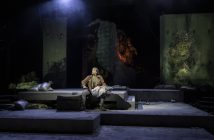“People often think they know the story already,” Al told me as we took our seats, but I didn’t get a chance to comment before a sudden and deafening bell toll nearly made me throw my J2O into the air. We were attempting to settle into the Olivier at the National Theatre for one of the most hotly anticipated productions of the year. Oscar-winning director Danny Boyle had returned to the theatre to helm Frankenstein, with Benedict Cumberbatch and Jonny Lee Miller assuming the roles of the Doctor and the Creature respectively on alternating nights. As the bell intermittently frightened the wits out of other unsuspecting audience members, Al, unfazed – which he attributed to his hearing, or lack thereof – continued, “but there have been a lot of liberties taken with Shelley’s book in the various productions over the years.”
Known previously for his minimalism in the theatre, Boyle was seemingly playing to type; we were faced with a large, circular cocoon tethered to a wooden frame revolving slowly around the stage. We could just make out the silhouette of a human form inside, writhing against the skin-like membrane. “He must be pretty thin,” commented Al. “You wouldn’t fit me in there.” Clever animatronics, I thought; that can’t be what I think it is.
But it was. As the lights dimmed, the membrane was torn open and a very naked Benedict Cumberbatch fell out. And for nigh on 15 minutes he twitched, gurned and groaned as his ‘creature’ learned to move, breathe and bring itself to life. He emitted an occasional howl as waves of light like schools of silvery fish rippled through a sea of lightbulbs hanging from the ceiling – all to the sound of electricity crackling around the auditorium. In these 15 minutes, playwright Nick Dear had summed up what we think we know about Frankenstein.
In contrast to the nakedness and solitude of this new life, the door at the rear of the stage opened up, sending a hissing, whistling locomotive roaring towards the audience. Another symbolic birth, perhaps – this one of the industrial age. Although, Al pointed out, as we adjourned for our customary post-theatre pizza, that might have been a tad anachronistic. Pedantry aside, it put Cumberbatch in context, if not in clothing. His being clad in only the robe his dismissive creator had thrown at him in a brief appearance; come to think of it, I had wondered when Lee Miller was going to appear and start experimenting, but in this case he came on, saw the creature and began shouting “No! No!” – surely the line should be “Yes! Yes!”? And “it’s ALIIIIIVE!!”? – before running off the stage. Here lay what I thought was the first departure from our knowledge of this well-thumbed story. Still, it was compelling stuff. Although, it would be a good quarter of an hour more before the Doctor made another appearance.
In the meantime, we see Cumberbatch beaten and driven by various Dickensian stereotypes into the wilderness, and experiencing his first fleeting taste of humanity in the form of a blind old man, De Lacey (a thoroughly sympathetic Karl Johnson), whereupon it – he – learns not only to speak but to recite Milton. “Again, something most interpretations tend to leave out,” Al told me. Understandable, really. Did you know Frankenstein’s monster quoted from Paradise Lost? “The creature’s capacity for retention is almost up there with his capacity for sociopathy,” explains Al, and this, while rather extraordinary, serves as an extraordinarily convenient way to get the monster talking; I can’t otherwise imagine many actors jumping at a part that simply groaned and garbled its way through the play.
That said, keeping him speechless might have aided the audience’s compassion for this wronged being: an erudite creature that kills and rapes indiscriminately and vengefully on a pretext of simply having been created – and being beaten up a couple of times, admittedly; oh, and being rejected by its creator – is far less sympathetic. This discourse, however, far from being a departure from Shelley’s story, encapsulates it. Once the creature begins to talk, he brings a voice to his emotions and the real story is thrust forward.
The central performances are spell-binding (I’m choosing my words carefully, I promise, these aren’t superlatives for superlatives’ sake) and, Cumberbatch’s physicality aside, Lee Miller’s obsessive Frankenstein has a flawed, distracted, almost Byronesque quality to it. The only thing – and I say only thing – for me, was that the love story between he and Elizabeth (Naomie Harris) was, on his part, diminished. It almost took the compassion out of his story, too.
The subtext and moral message aside, it’s the stagecraft of this production that is the most stunning element. The design is spectacularly inventive – most of this, after all, is spectacle, moving as it does from Geneva to Scotland to the Arctic circle. “How does he travel, by the way?” asked Al. “Suspension of disbelief, old boy,” I mused. “Besides, that’s academic; he can stow away on a boat, can’t he?” That would just be exposition, though, and this adaptation cuts right through that to the meat of the story. Gone is the introduction of Victor and his whacky ideas, gone are the laborious lab sequences and experiments. The spectacle aside, when it comes down to it, it really is the subtext – man’s inhumanity to man and the study of that – that is the point of Mary Shelley’s book. Dear and Boyle have simply omitted the clichés.




